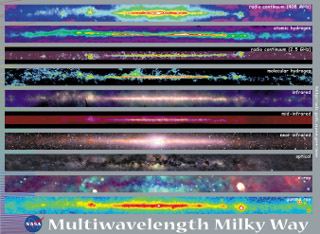Multiwavelength Milky Way: Imagine that you are looking up at the night sky and can see the arms of the Milky Way Galaxy bisecting the sky. The image of the sky labelled optical in this graphic is what you would see with your eyes. Now, observe the images of the same view of the Milky Way, but in through the lens of a telescope that sees in a different wavelength than our eyes. The amount and type of information, or data, available in each waveband varies as illustrated in this graphic. You can see why it is so important that we look at the Universe through eyes that see wavebands other than optical light.
Credit: NASA/GSFC
Why does it matter that we look at the sky in different energy bands? Let me give you an analogy. Do you like art? Let’s say you go to a museum to understand your favorite artist - from Salvador Dali to Rembrandt. But the museum you go to makes you look at all of these beautiful paintings wearing glasses that only let through red light. All you can see is the red in the picture, not all of the other colors or details that aren’t in the red region. How much do you think you would understand about that work of art if you could only see part of it?
When we look at the sky in various energy bands, when we have the actual multiwavelength coverage, then all of a sudden you can appreciate the whole picture. It’s a very narrow picture if you’re only looking at the optical or ultraviolet regions, or for that matter just the blue in a painting. It’s by having all the information that you might be able to figure out the story of that phenomenon in space. Just like with art, if you don’t get to see all the colors, you’re not getting the complete picture. Of course our eyes are limited to seeing only a narrow band of visible light, the spectrum of the rainbow. But there is so much more to see with telescopes and instruments that can detect various energy levels.
This is what multiwavelength astronomy is all about – getting a complete picture. In order for us to understand the world, astronomers want to see phenomena in space at all energy bands. Each of these energy bands has unique characteristics that contribute to the big picture. And as I said, I like explosives, so I am into the high energy phenomena associated with the creation of elements (nucleosynthesis), supernovae, and gamma-ray bursts.


